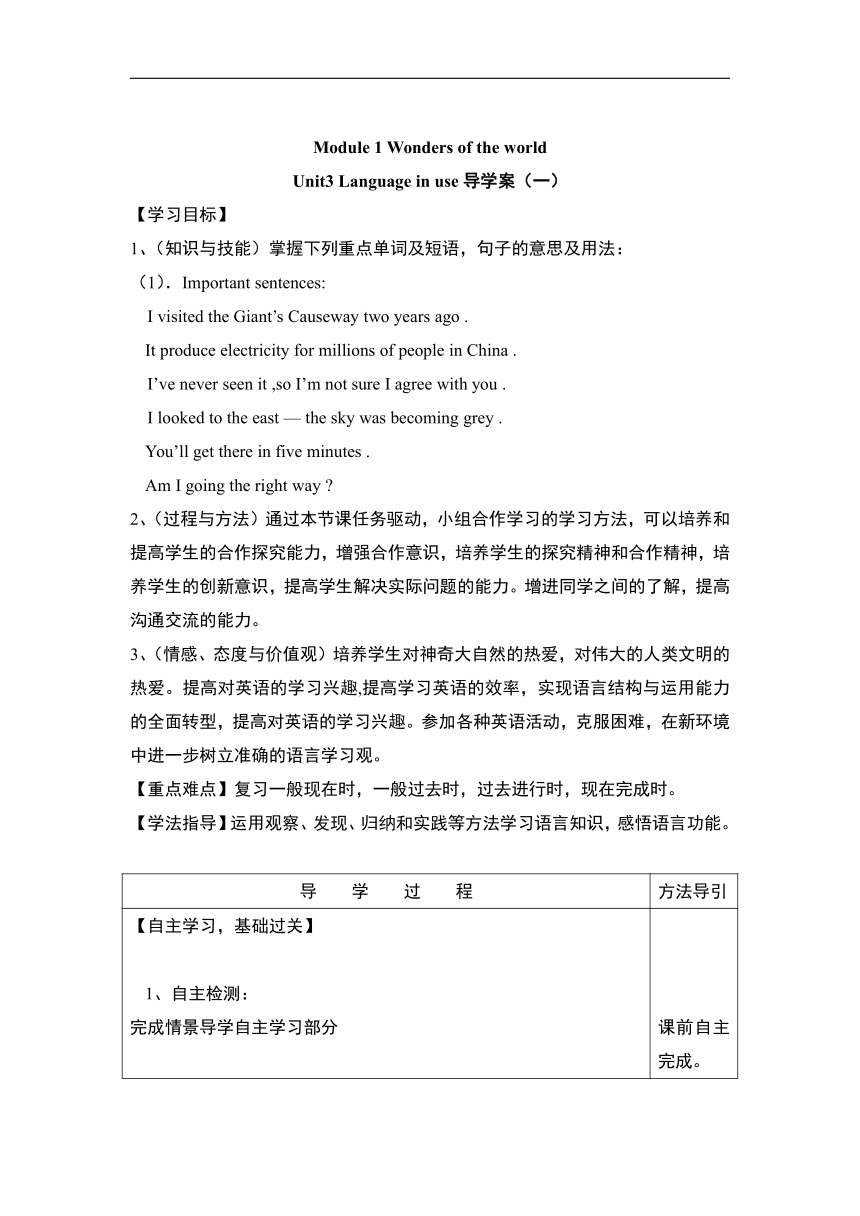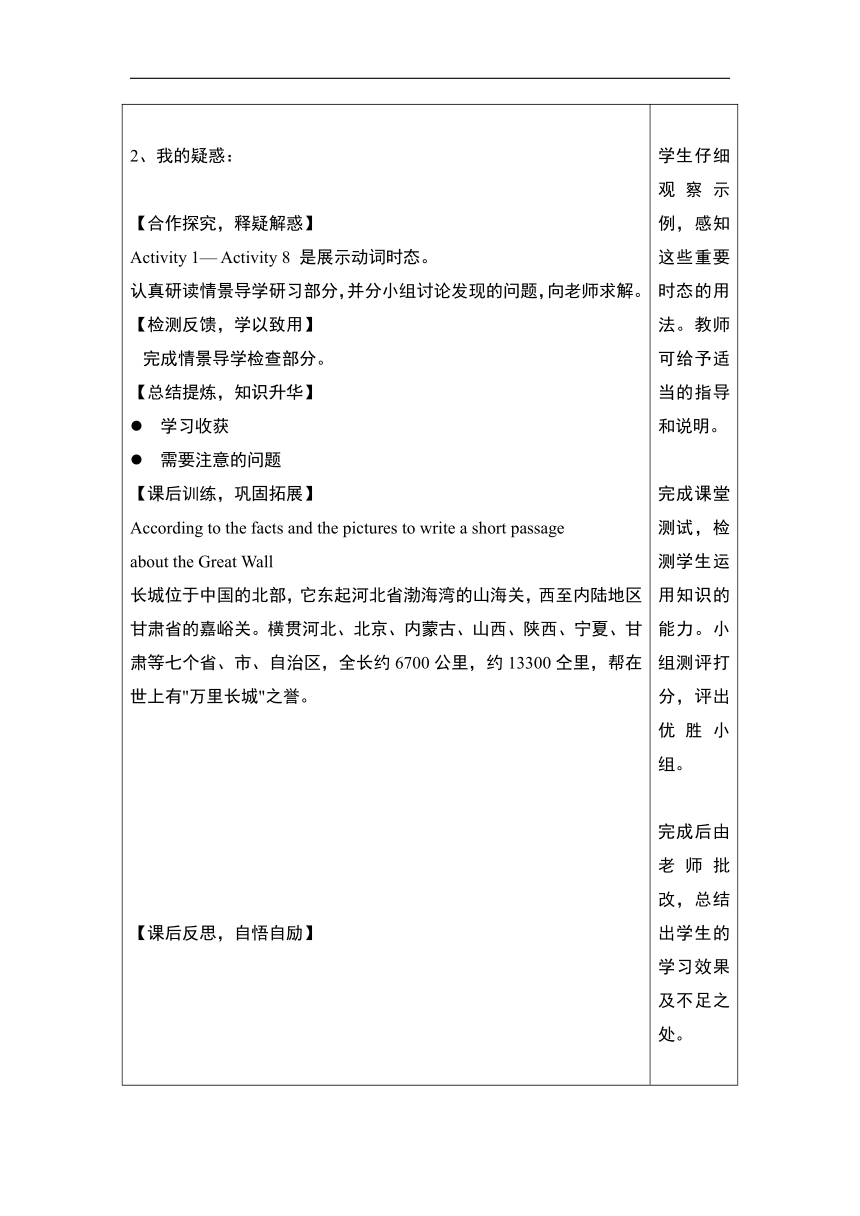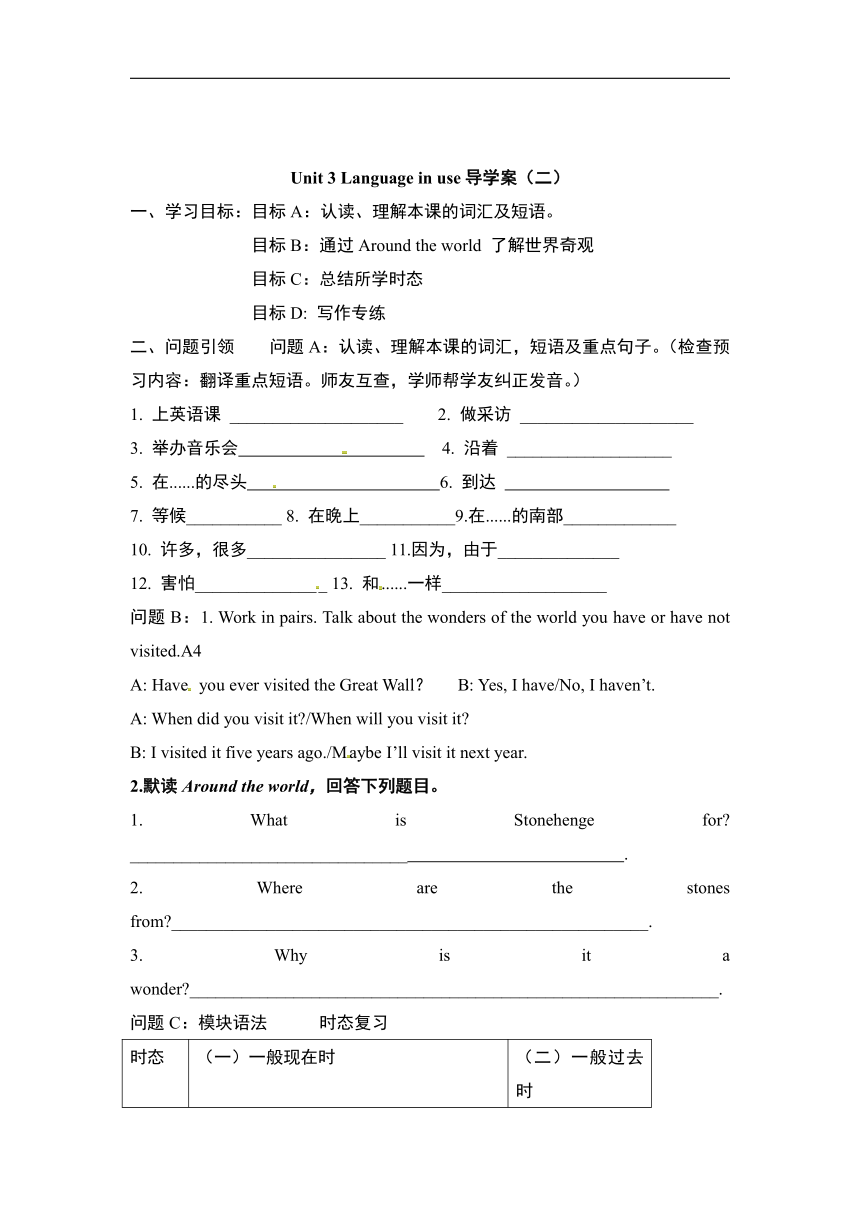外研版英语九年级上Module 1 Wonders of the world Unit 3 Language in use导学案(3份)
文档属性
| 名称 | 外研版英语九年级上Module 1 Wonders of the world Unit 3 Language in use导学案(3份) |

|
|
| 格式 | doc | ||
| 文件大小 | 164.5KB | ||
| 资源类型 | 教案 | ||
| 版本资源 | 外研版 | ||
| 科目 | 英语 | ||
| 更新时间 | 2021-10-19 22:53:05 | ||
图片预览



文档简介
Module 1 Wonders of the world
Unit3 Language in use导学案(一)
【学习目标】
1、(知识与技能)掌握下列重点单词及短语,句子的意思及用法:
(1).Important sentences:
I visited the Giant’s Causeway two years ago .
It produce electricity for millions of people in China .
I’ve never seen it ,so I’m not sure I agree with you .
I looked to the east — the sky was becoming grey .
You’ll get there in five minutes .
Am I going the right way
2、(过程与方法)通过本节课任务驱动,小组合作学习的学习方法,可以培养和提高学生的合作探究能力,增强合作意识,培养学生的探究精神和合作精神,培养学生的创新意识,提高学生解决实际问题的能力。增进同学之间的了解,提高沟通交流的能力。
3、(情感、态度与价值观)培养学生对神奇大自然的热爱,对伟大的人类文明的热爱。提高对英语的学习兴趣,提高学习英语的效率,实现语言结构与运用能力的全面转型,提高对英语的学习兴趣。参加各种英语活动,克服困难,在新环境中进一步树立准确的语言学习观。
【重点难点】复习一般现在时,一般过去时,过去进行时,现在完成时。
【学法指导】运用观察、发现、归纳和实践等方法学习语言知识,感悟语言功能。
导 学 过 程 方法导引
【自主学习,基础过关】1、自主检测:完成情景导学自主学习部分2、我的疑惑:【合作探究,释疑解惑】Activity 1— Activity 8 是展示动词时态。认真研读情景导学研习部分,并分小组讨论发现的问题,向老师求解。【检测反馈,学以致用】 完成情景导学检查部分。【总结提炼,知识升华】学习收获需要注意的问题 【课后训练,巩固拓展】According to the facts and the pictures to write a short passage
about the Great Wall
长城位于中国的北部,它东起河北省渤海湾的山海关,西至内陆地区甘肃省的嘉峪关。横贯河北、北京、内蒙古、山西、陕西、宁夏、甘肃等七个省、市、自治区,全长约6700公里,约13300仝里,帮在世上有"万里长城"之誉。 【课后反思,自悟自励】 课前自主完成。学生仔细观察示例,感知这些重要时态的用法。教师可给予适当的指导和说明。完成课堂测试,检测学生运用知识的能力。小组测评打分,评出优胜小组。完成后由老师批改,总结出学生的学习效果及不足之处。
Unit 3 Language in use导学案(二)
一、学习目标:目标A:认读、理解本课的词汇及短语。
目标B:通过Around the world 了解世界奇观
目标C:总结所学时态
目标D: 写作专练
二、问题引领 问题A:认读、理解本课的词汇,短语及重点句子。(检查预习内容:翻译重点短语。师友互查,学师帮学友纠正发音。)
1. 上英语课 ____________________ 2. 做采访 ____________________
3. 举办音乐会 4. 沿着 ___________________
5. 在......的尽头 6. 到达
7. 等候___________ 8. 在晚上___________9.在......的南部_____________
10. 许多,很多________________ 11.因为,由于______________
12. 害怕_______________ 13. 和......一样___________________
问题B:1. Work in pairs. Talk about the wonders of the world you have or have not visited.A4
A: Have you ever visited the Great Wall? B: Yes, I have/No, I haven’t.
A: When did you visit it /When will you visit it
B: I visited it five years ago./Maybe I’ll visit it next year.
2.默读Around the world,回答下列题目。
1. What is Stonehenge for ________________________________ .
2. Where are the stones from _______________________________________________________.
3. Why is it a wonder _____________________________________________________________.
问题C:模块语法 时态复习
时态 (一)一般现在时 (二)一般过去时
概念 经常性习惯性的动作或存在的状态
句式结构 am/is/are+表语
there is/are
实义动词作谓语
常用时间状语 Always,often,usually,sometimes,seldom,never,every day/month/week/year
Work in pairs and check.
时态 (三)现在进行时 (四)过去进行时
概念
句式
常用时间状语
一般将来时
概念:将要发生的动作或存在的状态。
2)句式结构: 造句
will/shall+动词原形
be going to+动词原形
be+doing(进行时表将来) leave,go,come,move等
常用时间状语:tomorrow,_____________________(后天),next week/_______/_______
____ two hours(两个小时后)________________(三天后)
现在完成时
概念:表示过去发生的动作对_______ 的影响,或表示动作从过去某时开始,一直延续到_____,并有可能继续延续下去。
句式结构:主+have/has+动词过去分词+其他
常用时间状语:already,yet,ever,never,__________(迄今为止),up till now,recently,lately,before,in the past/last...years,for+时间段,since+时间点等。Try to make sentences.
问题D:写作专练
请根据下面的表格提示向外国朋友介绍北京及北京几个著名的景点。(词数90左右)
总括 1.北京具有悠久的历史2.有许多名胜古迹
景点 最受来宾欢迎的紫禁城2.非常漂亮的颐和园3.美丽壮观的长城4.可以去漫步的天安门广场
参考词汇:紫禁城the Forbidden City,颐和园the Summer Palace 天安门广场Tian’anmen Square
写作指导:1.开篇点题Beijing is a city .There are many_____ __ _____ in it.
具体介绍或分层介绍 The Forbidden City is...The Summer Palace is...
作出评价或表达希望I hope you will...
Unit 3 Language in use导学案(三)
【要点探究】
1. because of因为; 由于
【语境领悟】
*It is a wonder also because of this question.
也是由于这个问题, 它成为一种奇观。
*He didn’t go to school because he was ill.
因为病了, 他没有去上学。
【自主归纳】
词 汇 词 性 用 法
because of 介词短语 后面接名词、代词、动名词等
because 连词 后面接原因状语从句
【学以致用】
由于天气不好, 他们推迟了运动会。
①They put off the sports meeting ______ ______the bad weather.
②They put off the sports meeting ______ the weather was bad.
2. have gone to去了
have been to去过
【语境领悟】
*She has gone to the Great Wall. 她去了长城。
*She has been to the Great Wall. 她去过长城。
*Mr. Green isn’t in. He has gone to Shanghai. He has
been there many times.
格林先生不在家。他去上海了。他去过那里很多次了。
【自主归纳】
(1)have gone to意为“去了……”, 着重指说话时不在现场, 一般用于第三人称。
(2)have been to意为“去过……”, 表示一种经历, 着重指现在已经回来, 不在那里了, 常与ever, just, never等词连用, 其后可接once, twice等表示次数的词。
【图解助记】
SHAPE \* MERGEFORMAT HYPERLINK "http://www.21cnjy.com/"
【学以致用】
①—Hello, may I speak to Miss Wang
—Sorry, she isn’t in. She ______ the office.
A. has been to B. has gone to C. has been away
②(鞍山中考)你曾经去过游乐园吗
__________ you ever __________ to an amusement park
时态复习: 一般现在时、一般过去时、现在进行时、过去进行时、一般将来时和现在完成时。
【语境领悟】
仔细观察, 体会例句中动词的时态。
①It produces electricity for millions of people in China.
②I visited the Giant’s Causeway two years ago.
③You’ll get there in five minutes.
④You are driving. Don’t talk on the phone.
⑤I’ve never seen it, so I’m not sure I agree with you.
⑥When I arrived, it was early morning and it was raining.
【知识构建】
(一)一般现在时
(1)用法: ①表示现在(或经常性)的情况或状态; ②表示经常的、习惯性的动作, 客观事实, 普遍真理;
(2)谓语形式: 动词原形或动词的第三人称单数形式;
(3)标志词: u ( http: / / www.21cnjy.com )sually, often, always, sometimes, every day/week/. . . 等。
(二)一般过去时
(1)用法: ①表示过去某个时间里存在的状态; ②表示过去某个时间里发生的动作或过去经常性的动作;
(2)谓语形式: 动词的过去式;
(3)标志词: yesterday, just now, last year/month/. . . , . . . ago, in 2012, in the past等。
(三)一般将来时
(1)用法: 表示将来会出现或发生的动作;
(2)谓语形式: will/shall/be going to +动词原形;
(3)标志 ( http: / / www.21cnjy.com )词: tomorrow, this evening, some day, next . . . , in +时间段, at the end of this term等。
(四)现在进行时
(1)用法: 表示说话时正在进行的动作或当前一段时间正在进行的动作;
(2)谓语形式: be+动词的现在分词(v. -ing);
(3)标志词: now, these days, look, listen, at the moment等。
(五)现在完成时
(1)用法: ①表示发生在过去的动作对现在仍有影响; ②表示从过去一直延续到现在的动作;
(2)谓语形式: have/has+动词的过去分词(v. -ed);
(3)标志词: already, just, never, before, recently, in the past few years, ever, so far, since+过去的时间点, for+时间段等。
(六)过去进行时
(1)用法: 表示过去某一时刻或某一段时间内正在发生的动作;
(2)谓语形式: was/were+动词的现在分词(v. -ing);
(3)标志词: at ( http: / / www.21cnjy.com )this time yesterday, at that time, at ten o’clock yesterday或when引导的从句等。
【学以致用】用所给词的适当形式填空。
1. When __________ Tom __________ (begin)to play the piano yesterday
2. —How soon __________ they __________ (get)here
—In about two hours.
3. Listen! Someone __________ (knock)at the door.
4. The students __________ (not read)the story yet.
5. The boys __________ (sing)in the room when I walked past.
6. I don’t know if it __________ (snow)tomorrow. If it __________ (snow), we will make a snowman.
Unit3 Language in use导学案(一)
【学习目标】
1、(知识与技能)掌握下列重点单词及短语,句子的意思及用法:
(1).Important sentences:
I visited the Giant’s Causeway two years ago .
It produce electricity for millions of people in China .
I’ve never seen it ,so I’m not sure I agree with you .
I looked to the east — the sky was becoming grey .
You’ll get there in five minutes .
Am I going the right way
2、(过程与方法)通过本节课任务驱动,小组合作学习的学习方法,可以培养和提高学生的合作探究能力,增强合作意识,培养学生的探究精神和合作精神,培养学生的创新意识,提高学生解决实际问题的能力。增进同学之间的了解,提高沟通交流的能力。
3、(情感、态度与价值观)培养学生对神奇大自然的热爱,对伟大的人类文明的热爱。提高对英语的学习兴趣,提高学习英语的效率,实现语言结构与运用能力的全面转型,提高对英语的学习兴趣。参加各种英语活动,克服困难,在新环境中进一步树立准确的语言学习观。
【重点难点】复习一般现在时,一般过去时,过去进行时,现在完成时。
【学法指导】运用观察、发现、归纳和实践等方法学习语言知识,感悟语言功能。
导 学 过 程 方法导引
【自主学习,基础过关】1、自主检测:完成情景导学自主学习部分2、我的疑惑:【合作探究,释疑解惑】Activity 1— Activity 8 是展示动词时态。认真研读情景导学研习部分,并分小组讨论发现的问题,向老师求解。【检测反馈,学以致用】 完成情景导学检查部分。【总结提炼,知识升华】学习收获需要注意的问题 【课后训练,巩固拓展】According to the facts and the pictures to write a short passage
about the Great Wall
长城位于中国的北部,它东起河北省渤海湾的山海关,西至内陆地区甘肃省的嘉峪关。横贯河北、北京、内蒙古、山西、陕西、宁夏、甘肃等七个省、市、自治区,全长约6700公里,约13300仝里,帮在世上有"万里长城"之誉。 【课后反思,自悟自励】 课前自主完成。学生仔细观察示例,感知这些重要时态的用法。教师可给予适当的指导和说明。完成课堂测试,检测学生运用知识的能力。小组测评打分,评出优胜小组。完成后由老师批改,总结出学生的学习效果及不足之处。
Unit 3 Language in use导学案(二)
一、学习目标:目标A:认读、理解本课的词汇及短语。
目标B:通过Around the world 了解世界奇观
目标C:总结所学时态
目标D: 写作专练
二、问题引领 问题A:认读、理解本课的词汇,短语及重点句子。(检查预习内容:翻译重点短语。师友互查,学师帮学友纠正发音。)
1. 上英语课 ____________________ 2. 做采访 ____________________
3. 举办音乐会 4. 沿着 ___________________
5. 在......的尽头 6. 到达
7. 等候___________ 8. 在晚上___________9.在......的南部_____________
10. 许多,很多________________ 11.因为,由于______________
12. 害怕_______________ 13. 和......一样___________________
问题B:1. Work in pairs. Talk about the wonders of the world you have or have not visited.A4
A: Have you ever visited the Great Wall? B: Yes, I have/No, I haven’t.
A: When did you visit it /When will you visit it
B: I visited it five years ago./Maybe I’ll visit it next year.
2.默读Around the world,回答下列题目。
1. What is Stonehenge for ________________________________ .
2. Where are the stones from _______________________________________________________.
3. Why is it a wonder _____________________________________________________________.
问题C:模块语法 时态复习
时态 (一)一般现在时 (二)一般过去时
概念 经常性习惯性的动作或存在的状态
句式结构 am/is/are+表语
there is/are
实义动词作谓语
常用时间状语 Always,often,usually,sometimes,seldom,never,every day/month/week/year
Work in pairs and check.
时态 (三)现在进行时 (四)过去进行时
概念
句式
常用时间状语
一般将来时
概念:将要发生的动作或存在的状态。
2)句式结构: 造句
will/shall+动词原形
be going to+动词原形
be+doing(进行时表将来) leave,go,come,move等
常用时间状语:tomorrow,_____________________(后天),next week/_______/_______
____ two hours(两个小时后)________________(三天后)
现在完成时
概念:表示过去发生的动作对_______ 的影响,或表示动作从过去某时开始,一直延续到_____,并有可能继续延续下去。
句式结构:主+have/has+动词过去分词+其他
常用时间状语:already,yet,ever,never,__________(迄今为止),up till now,recently,lately,before,in the past/last...years,for+时间段,since+时间点等。Try to make sentences.
问题D:写作专练
请根据下面的表格提示向外国朋友介绍北京及北京几个著名的景点。(词数90左右)
总括 1.北京具有悠久的历史2.有许多名胜古迹
景点 最受来宾欢迎的紫禁城2.非常漂亮的颐和园3.美丽壮观的长城4.可以去漫步的天安门广场
参考词汇:紫禁城the Forbidden City,颐和园the Summer Palace 天安门广场Tian’anmen Square
写作指导:1.开篇点题Beijing is a city .There are many_____ __ _____ in it.
具体介绍或分层介绍 The Forbidden City is...The Summer Palace is...
作出评价或表达希望I hope you will...
Unit 3 Language in use导学案(三)
【要点探究】
1. because of因为; 由于
【语境领悟】
*It is a wonder also because of this question.
也是由于这个问题, 它成为一种奇观。
*He didn’t go to school because he was ill.
因为病了, 他没有去上学。
【自主归纳】
词 汇 词 性 用 法
because of 介词短语 后面接名词、代词、动名词等
because 连词 后面接原因状语从句
【学以致用】
由于天气不好, 他们推迟了运动会。
①They put off the sports meeting ______ ______the bad weather.
②They put off the sports meeting ______ the weather was bad.
2. have gone to去了
have been to去过
【语境领悟】
*She has gone to the Great Wall. 她去了长城。
*She has been to the Great Wall. 她去过长城。
*Mr. Green isn’t in. He has gone to Shanghai. He has
been there many times.
格林先生不在家。他去上海了。他去过那里很多次了。
【自主归纳】
(1)have gone to意为“去了……”, 着重指说话时不在现场, 一般用于第三人称。
(2)have been to意为“去过……”, 表示一种经历, 着重指现在已经回来, 不在那里了, 常与ever, just, never等词连用, 其后可接once, twice等表示次数的词。
【图解助记】
SHAPE \* MERGEFORMAT HYPERLINK "http://www.21cnjy.com/"
【学以致用】
①—Hello, may I speak to Miss Wang
—Sorry, she isn’t in. She ______ the office.
A. has been to B. has gone to C. has been away
②(鞍山中考)你曾经去过游乐园吗
__________ you ever __________ to an amusement park
时态复习: 一般现在时、一般过去时、现在进行时、过去进行时、一般将来时和现在完成时。
【语境领悟】
仔细观察, 体会例句中动词的时态。
①It produces electricity for millions of people in China.
②I visited the Giant’s Causeway two years ago.
③You’ll get there in five minutes.
④You are driving. Don’t talk on the phone.
⑤I’ve never seen it, so I’m not sure I agree with you.
⑥When I arrived, it was early morning and it was raining.
【知识构建】
(一)一般现在时
(1)用法: ①表示现在(或经常性)的情况或状态; ②表示经常的、习惯性的动作, 客观事实, 普遍真理;
(2)谓语形式: 动词原形或动词的第三人称单数形式;
(3)标志词: u ( http: / / www.21cnjy.com )sually, often, always, sometimes, every day/week/. . . 等。
(二)一般过去时
(1)用法: ①表示过去某个时间里存在的状态; ②表示过去某个时间里发生的动作或过去经常性的动作;
(2)谓语形式: 动词的过去式;
(3)标志词: yesterday, just now, last year/month/. . . , . . . ago, in 2012, in the past等。
(三)一般将来时
(1)用法: 表示将来会出现或发生的动作;
(2)谓语形式: will/shall/be going to +动词原形;
(3)标志 ( http: / / www.21cnjy.com )词: tomorrow, this evening, some day, next . . . , in +时间段, at the end of this term等。
(四)现在进行时
(1)用法: 表示说话时正在进行的动作或当前一段时间正在进行的动作;
(2)谓语形式: be+动词的现在分词(v. -ing);
(3)标志词: now, these days, look, listen, at the moment等。
(五)现在完成时
(1)用法: ①表示发生在过去的动作对现在仍有影响; ②表示从过去一直延续到现在的动作;
(2)谓语形式: have/has+动词的过去分词(v. -ed);
(3)标志词: already, just, never, before, recently, in the past few years, ever, so far, since+过去的时间点, for+时间段等。
(六)过去进行时
(1)用法: 表示过去某一时刻或某一段时间内正在发生的动作;
(2)谓语形式: was/were+动词的现在分词(v. -ing);
(3)标志词: at ( http: / / www.21cnjy.com )this time yesterday, at that time, at ten o’clock yesterday或when引导的从句等。
【学以致用】用所给词的适当形式填空。
1. When __________ Tom __________ (begin)to play the piano yesterday
2. —How soon __________ they __________ (get)here
—In about two hours.
3. Listen! Someone __________ (knock)at the door.
4. The students __________ (not read)the story yet.
5. The boys __________ (sing)in the room when I walked past.
6. I don’t know if it __________ (snow)tomorrow. If it __________ (snow), we will make a snowman.
同课章节目录
- Module 1 Wonders of the world
- Unit 1 It's more than 2,000 years old.
- Unit 2 The Grand Canyon was not just big.
- Unit 3 Language in use
- Module 2 Public holidays
- Unit 1 My family always go somewhere interesting a
- Unit 2 We have celebrated the festival since the f
- Unit 3 Language in use
- Module 3 Heroes
- Unit 1 She trained hard,so she became a great play
- Unit 2There were few doctors, so he had to work ve
- Unit 3 Language in use
- Module 4 Home alone
- Unit 1 I can look after myself, although it won’t
- Unit 2 I became so bored with their orders that I
- Unit 3 Language in use
- Module 5 Museums
- Unit 1 Don't cross that rope!
- Unit 2 If you ever go to London, make sure you vis
- Unit 3 Language in use
- Module 6 Problems
- Unit 1 If I start after dinner, I'll finish it be
- Unit 2 If you tell him the truth now, you will sho
- Unit 3 Language in use
- Revision Module A
- Module 7 Great books
- Unit 1 We're still influenced by Confucius's idea
- Unit 2 It is still read and loved.
- Unit 3 Language in use
- Module 8 Sports life
- Unit 1 Daming wasn't chosen for the team last time
- Unit 2 He was invited to competitions around the w
- Unit 3 Language in use
- Module 9 Great inventions
- Unit 1 Will computers be used more than books in t
- Unit 2 Will books be replaced by the Internet?
- Unit 3 Language in use
- Module 10 Australia
- Unit 1 I have some photos that I took in Australia
- Unit 2 The game that they like most is Australian
- Unit 3 Language in use
- Module 11 Photos
- Unit 1 He's the boy who won the photo competition
- Unit 2 The photo which we liked best was taken by
- Unit 3 Language in use
- Module 12 Save our world
- Unit 1 If everyone starts to do something, the wor
- Unit 2 Repeat these three words daily: reduce, reu
- Unit 3 Language in use
- Revision Module B
